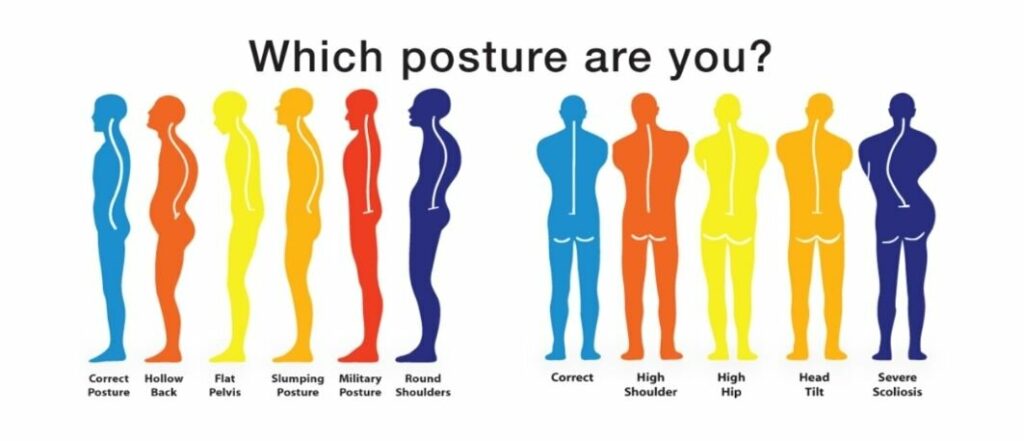At Innate Health Chiropractic Exeter our goal is to understand your aches and pains in the most holistic and comprehensive way possible. We do this using our 3 pillars. From experience we have found there are three powerful ways to measure how your body is functioning and performing, and these three aspects relate directly to why there is pain or discomfort. These three aspects are all essential to good health and function, so we assess these in detail on your first visit, and continually throughout your care to monitor progress. The three aspects are posture, movement and muscle function.
Posture: This is the first of the 3 pillars. Everyone is aware how important good posture is for wellbeing and for the health of your joints and muscles. In a textbook perfect scenario, the posture is balanced and symmetrical, as shown below in the picture. Notice the equal balanced position of the pelvis, shoulders and head. They are equal in height and so the posture balanced. When balanced, there won’t be any uneven strain on the joints caused by more weight or loading on one side. Also when the posture is not symmetrical, there will be uneven muscle strain on one side. For example, if one side of the pelvic crest is higher, this will ‘hike’ up the leg on that side and create a shorter leg, The muscles around it will be tighter and the muscles on the opposite will be strained as they try to ‘pull’ the spine back in to a balanced posture. Another common example is when the head is tilted to one side. Again this will strain the joints and muscles on that side and irritate the muscles on the opposite side that are being stretched. In our techniques we find there are 3 main postural compensation patterns that develop; the predominant finding will be one side of the pelvis will be higher than the other, the opposite shoulder tends to be higher to try to keep the spine straight, and the head will usually tilt towards the high shoulder side. These postural changes create strain patterns that affect specific muscles, resulting in muscle shortening and weakening.
Movement: Movement is perhaps the most essential aspect of the musculoskeletal system, particularly in relation to the spine. This is our second of the 3 pillars. Vertebrae are designed to move freely in all three planes, allowing for unrestricted supple movement. When the vertebrae become restricted and lose their full range of motion, you’ll notice that you can’t move as far and easily as before. You may notice you can’t turn your head so far when you’re reversing the car, or bending forward to pick something up feels tight and sore in the low back. We assess your movement and range of motion to find where these restrictions are. First we look at the range of motion in the neck, the shoulders, the low back and pelvis, ribcage and hips. Then we look more closely at those restricted movements to find the specific joint or vertebra involved. For example, if your neck rotation is blocked to one side, it may come from a restricted vertebra at the top of the neck.
Muscle function: Muscle and joint function are inseparable. So when you have restricted movement in joints, this will affect the muscles around it that attach nearby or that are related to the particular joint. For instance, if your right hip doesn’t turn in as far as it should, there will be muscles around the hip that become tight, contracted and weak. We can assess the muscle function by testing the strength of the muscle, as well as feeling the muscle for tightness and ‘knots’, known as trigger points.
“By assessing these three pillars thoroughly, we can see where the primary problems are, and direct our treatment to get the best long-term result that not only addresses the pain but addresses the underlying changes in the posture, movement and muscle function of the body. ”
As you can see, these three aspects of posture, movement and muscle function are all interrelated, because they are interdependent with one another. If your posture is not balanced, there will be changes to how the joints move, and the postural pattern and restricted movement will both affect the muscles in that area. This requires a holistic approach, because if the therapist only addresses one aspect, let’s say by only treating the muscles, there may only be short term relief because the posture and movement may not improve.

The light blue image shows a symmetric balanced posture. The other images show variations of the various postural strain patterns, with uneven hips, shoulders and head tilt. These changes affect the muscle balance, resulting in various points of strain and contraction.
References
Posture image: Radiant Life Chiropractic. 21 Tips for better posture. [Online]. Available at getradiantlife.com/21-tips-better-posture/ [accessed 16 September 2021]
